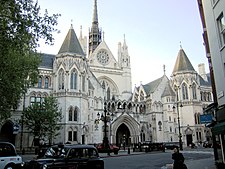Court of Appeal of England and Wales
| Her Majesty's Court of Appeal in England and Wales | |
|---|---|

|
|
| Established | 1875 |
| Country | England and Wales, UK |
| Location | Royal Courts of Justice, Strand, City of Westminster, London, UK |
| Authorized by | Senior Courts Act 1981 |
| Decisions are appealed to | Supreme Court of the United Kingdom |
| Lord Chief Justice of England and Wales | |
| Currently | Lord Thomas of Cwmgiedd |
| Since | 1 October 2013 |
| Master of the Rolls | |
| Currently | Sir Terence Etherton |
| Since | 3 October 2016 |
Within the English legal system, the Court of Appeal (formally Her Majesty's Court of Appeal in England & Wales) is second only to the Supreme Court. Established in 1875, the Court of Appeal today comprises 38 Lord Justices of Appeal.
The Court has two divisions, Criminal and Civil, led by the Lord Chief Justice and Master of the Rolls respectively. Criminal appeals are heard in its Criminal Division, and civil appeals in the Civil Division. The Criminal Division also hears appeals from the Crown Court, while the Civil Division hears appeals from the County Courts and High Court of Justice. Leave to appeal is required from either the lower court or the Court of Appeal itself; and with leave, further appeal may lie to the Supreme Court.
The appeal system before 1875 was "chaotic". The superior courts system consisted of 12 different courts, with appeal on common law matters to the Court of Exchequer Chamber, chancery matters to the Court of Appeal in Chancery and other matters to the Privy Council. This was the subject of a review by the Judicature Commission, established in 1867 to consider the creation of a "Supreme Court" (a High Court and Court of Appeal) which was published in 1869. The recommendation was that there should be a common system of appeal from all of the High Court divisions, with a limited set of appeals allowed to the House of Lords. This was instituted by the Judicature Acts, with the Appellate Jurisdiction Act 1876 giving an almost limitless right of appeal to the Lords.
...
Wikipedia
